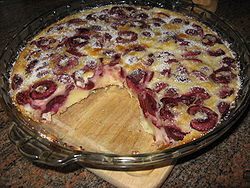 Clafoutis made with pitted cherries Clafoutis made with pitted cherries | |
| Type | Tart |
|---|---|
| Course | Dessert, breakfast |
| Place of origin | France |
| Region or state | Limousin |
| Serving temperature | Warm, room temperature, or chilled |
| Main ingredients | Eggs, milk or yogurt, black cherries or other fruit |
| Ingredients generally used | Flour or almond flour, fruit brandy, powdered sugar, sugar |
| Variations | Flaugnarde |
Clafoutis (French pronunciation: [klafuti]; Occitan: clafotís [klafuˈtis] or [kʎafuˈtiː]), sometimes spelled clafouti in Anglophone countries, is a French dish of fruit, traditionally unpitted black cherries, arranged in a buttered dish, covered with a thick but pourable batter, then baked to create a crustless tart. The clafoutis is traditionally dusted with powdered sugar and served lukewarm, sometimes with cream, as a dessert. It can also be served as a breakfast or brunch main or side dish. It originates in the Limousin region.
Etymology
One proposed derivation of the dish's name is from the Occitan clafotís, from the verb clafir, meaning "to fill" (implied: "the batter with cherries"). Another is that clafir comes from the old French claufir, meaning "to fix with nails," explained as the cherries having the appearance of nail heads.
Cyanide
A traditional Limousin clafoutis contains both the flesh of the cherries and the nut-like kernels. Cherry kernels contain benzaldehyde, the compound responsible for the dominant flavour in almond extract. They also contain a small amount of amygdalin, a cyanogenic glycoside - a compound potentially capable of releasing cyanide if consumed, but non-toxic in small quantities.
Origin
Clafoutis comes from the Limousin region of France.
Variations and similar dishes

While unpitted black cherries are traditional, there are numerous variations using other fruits, including pitted red or black cherries, other stonefruit such as peaches or plums, other fruit such as apples or pears, or berries.
A flaugnarde is a similar dessert but made with other fruits such as apples, pears, apricots or plums. Cacou, a specialty of Paray-le-Monial, is a dessert similar to clafoutis made with unpitted Bigarreaux cherries. Far Breton is a dessert similar to clafoutis made with prunes. A flan is a similar dish made with a flourless batter.
Savoury clafoutis, made with vegetables and without sugar, can also be made.
Ingredients, preparation and serving
A pourable batter, similar in thickness to a pancake batter, is made from flour, eggs, milk, sugar, and salt and sometimes other ingredients such as almond flour, yogurt, and flavorings such as vanilla or kirsch or other fruit brandies. The batter is poured over cherries or other fruit in a shallow baking dish and baked. Some recipes call for pouring the batter into the pan and topping with the fruit before baking. The finished product has a light, custardlike texture.
The dish is traditionally served as a dessert, but some less-sweet variations may also be appropriate as a breakfast or brunch dish. It can be served warm, at room temperature, or chilled. It may be served sprinkled with powdered sugar and may be served alone or with accompaniments such as cream, whipped cream, or ice cream.
Cultural references
In her autobiographical novel The War: A Memoir, French Resistance member and writer Marguerite Duras wrote that she carefully gathered the rationed ingredients to make her husband a clafoutis when he returns from a concentration camp, only to find that he is too weak from malnutrition and exposure to eat it.
See also
References
- The Oxford Companion to Sugar and Sweets. Oxford University Press. 2015-04-01. ISBN 9780199313617.
- "Dictionnaire de l'Académie française, 9th edition online". Retrieved 2021-11-19.
- "Wiktionary". Retrieved 2021-11-19.
- "CLAFOUTIS : Définition". cnrtl.fr. Retrieved 22 August 2023.
flan fait d'un mélange de farine, de lait, d'œufs et de sucre, que l'on fait cuire au four dans une tourtière beurrée après y avoir ajouté des cerises sucrées [flan made from a mixture of flour, milk, eggs and sugar, which is baked in a buttered pie pan after adding sweet cherries
- "Clafoutis". The Concise Larousse Gastronomique: The World's Greatest Cookery Encyclopedia (Revised ed.). London: Hamlyn, a division of Octopus Publishing Group. 2003-04-15 . p. 311. ISBN 978-0600608639.
- "cherry clafoutis". A Toast and Tea. July 6, 2011. Archived from the original on August 17, 2020. Retrieved June 5, 2019.
- Nick, Jean (July 25, 2018). "Are Stone Fruit Seeds Poisonous? What to Know About Cherry, Peach, and Plum Pits". Good Housekeeping. Retrieved June 5, 2019.
- Larousse Gastronomique, Clarkson Potter Publishers
- ^ Sacks, Katherine (2015-07-28). "The Easy French Dessert Great For All Your Summer Fruit". Epicurious. Retrieved 2023-10-24.
- ^ "What is Clafoutis and How to Make It?". Fine Dining Lovers. Retrieved 2023-10-24.
- ^ "Easy Cherry Clafoutis Recipe". Tasting Table. 2022-02-14. Retrieved 2023-10-24.
- *"Regional produces". Office de Tourisme de Paray-le-Monial. Retrieved 22 August 2023.
THE CACOU, A SPECIALITY FROM PARAY-LE-MONIAL
- "Le cacou aux cerises, spécialité parodienne proche du clafoutis". Jours-de-marche.fr. Retrieved 22 August 2023.
- "LE CACOU, GÂTEAU AUX CERISES (PARAY-LE-MONIAL)". CUISINE TERROIRS (in French). 8 June 2022. Retrieved 22 August 2023.
- *"Bigarreaux (fruits)". L'Académie du Goût (in French). Retrieved 22 August 2023.
- "Bigarreau". definition - American English. Collins English Dictionary. Retrieved 22 August 2023.
- "Bigarreaux". Good Fruit Guide. Retrieved 22 August 2023.
- "Bigarreau". Getty Images. Retrieved 22 August 2023.
- "Bigarreaux". Alamy. Retrieved 22 August 2023.
- Appellate Division First Department (1911). T-S v O&C. New York Supreme Court. p. 1012. Retrieved 22 August 2023.
bigarreaux
- ^ "Toutes nos recettes de flans et clafoutis aux légumes d'été". Marie Claire (in French). Retrieved 2023-10-24.
- ^ Shulman, Martha Rose (23 May 2014). "Berry Clafoutis Recipe". NYT Cooking. Retrieved 2023-10-24.
- ^ Clair, Jennifer (2018-09-13). "The Anytime, Any-Fruit French Dessert You Can Make in Your Sleep". Food52. Retrieved 2023-10-24.
- Duras, Marguerite (1986). The War: A Memoir. Trans Barbara Bray. New York: The New Press, 1986, p. 55. Published in French as La Douleur, 1985.